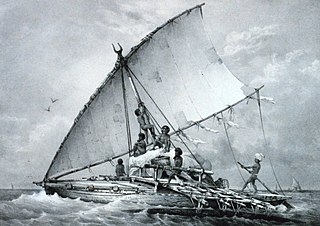
The history of Madagascar is distinguished clearly by the early isolation of the landmass from the ancient supercontinent containing Africa and India, and by the island's late colonization by human settlers from the Sunda islands and from East Africa. These two factors facilitated the evolution and survival of thousands of endemic plant and animal species, some of which have gone extinct or are currently threatened with extinction due to the government not allocating resources to help the growing population, causing many people to resort to harmful environmental practices as a way of survival. Trade in the Indian Ocean at the time of first colonization of Madagascar was dominated by large ships, called Djong, coming from Java and Sumatra.

Antananarivo, also known by its colonial shorthand form Tana, is the capital and largest city of Madagascar. The administrative area of the city, known as Antananarivo-Renivohitra, is the capital of Analamanga region. The city sits at 1,280 m (4,199 ft) above sea level in the center of the island, the highest national capital by elevation among the island countries. It has been the country's largest population center since at least the 18th century. The presidency, National Assembly, Senate and Supreme Court are located there, as are 21 diplomatic missions and the headquarters of many national and international businesses and NGOs. It has more universities, nightclubs, art venues, and medical services than any city on the island. Several national and local sports teams, including the championship-winning national rugby team, the Makis are based here.
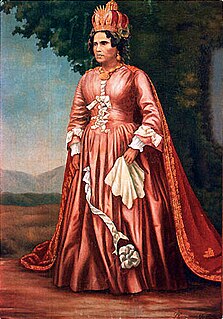
Ranavalona I, also known as Ranavalo-Manjaka I, was sovereign of the Kingdom of Madagascar from 1828 to 1861. After positioning herself as queen following the death of her young husband, Radama I, Ranavalona pursued a policy of isolationism and self-sufficiency, reducing economic and political ties with European powers, repelling a French attack on the coastal town of Foulpointe, and taking vigorous measures to eradicate the small but growing Malagasy Christian movement initiated under Radama I by members of the London Missionary Society. She made heavy use of the traditional practice of fanompoana to complete public works projects and develop a standing army of between 20,000 and 30,000 Merina soldiers, whom she deployed to pacify outlying regions of the island and further expand the realm. The combination of regular warfare, disease, difficult forced labor and harsh trials by ordeal using a poisonous nut from the Tangena shrub resulted in a high mortality rate among both soldiers and civilians during her 33-year reign, with Madagascar's population reducing from 5 million in 1833 to 2.5 million in 1839.
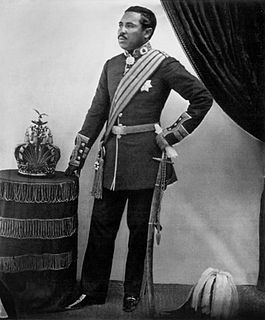
Radama II was the son and heir of Queen Ranavalona I and ruled from 1861 to 1863 over the Kingdom of Madagascar, which controlled virtually the entire island. Radama's rule, although brief, was a pivotal period in the history of the Kingdom of Madagascar. Under the unyielding and often harsh 33-year rule of his mother, Queen Ranavalona I, Madagascar had successfully preserved its cultural and political independence from European colonial designs. Rejecting the queen's policy of isolationism and persecution of Christians, Radama II permitted religious freedom and re-opened Madagascar to European influence. Under the terms of the Lambert Charter, which Radama secretly contracted in 1855 with French entrepreneur Joseph-François Lambert while Ranavalona still ruled, the French were awarded exclusive rights to the exploitation of large tracts of valuable land and other lucrative resources and projects. This agreement, which was later revoked by Prime Minister Rainilaiarivony, was key to establishing France's claim over Madagascar as a protectorate and, in 1896, as a colony.
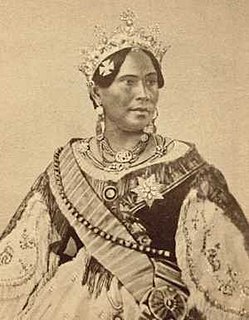
Rasoherina was Queen of Madagascar from 1863 to 1868, succeeding her husband Radama II following his presumed assassination.
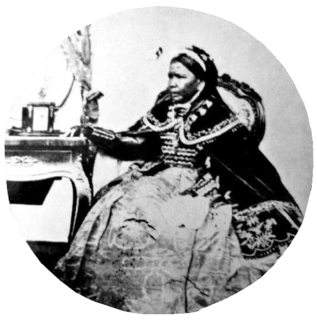
Ranavalona II was Queen of Madagascar from 1868 to 1883, succeeding Queen Rasoherina, her first cousin. She is best remembered for Christianizing the royal court during her reign.

Ranavalona III was the last sovereign of the Kingdom of Madagascar. She ruled from July 30, 1883 to February 28, 1897 in a reign marked by ultimately futile efforts to resist the colonial designs of the government of France. As a young woman, she was selected from among several Andriana qualified to succeed Queen Ranavalona II upon her death. Like both preceding queens, Ranavalona entered a political marriage with a member of the Hova elite named Rainilaiarivony, who largely oversaw the day-to-day governance of the kingdom and managed its foreign affairs in his role as prime minister. Ranavalona tried to stave off colonization by strengthening trade and diplomatic relations with foreign powers throughout her reign, but French attacks on coastal port towns and an assault on the capital city of Antananarivo led to the capture of the royal palace in 1895, ending the sovereignty and political autonomy of the century-old kingdom.

Ambohimanga is a hill and traditional fortified royal settlement (rova) in Madagascar, located approximately 24 kilometers (15 mi) northeast of the capital city of Antananarivo. It is situated in the commune of Ambohimanga Rova.

Rainilaiarivony was a Malagasy politician who served as the prime minister of Madagascar from 1864 to 1895, succeeding his older brother Rainivoninahitriniony, who had held the post for thirteen years. His career mirrored that of his father Rainiharo, a renowned military man who became prime minister during the reign of Queen Ranavalona I.

Joseph-François Lambert, the "Duke of Imerina" (1824–1873) was a French adventurer, businessman, and diplomat who fathered the Lambert Charter.

The Franco-Hova Wars, also known as the Franco-Malagasy Wars were two French military interventions in Madagascar between 1883 and 1896 that overthrew the ruling monarchy of the Merina Kingdom, and resulted in Madagascar becoming a French colony. The term "Hova" referred to a social class within the Merina class structure.

The Rova of Antananarivo is a royal palace complex (rova) in Madagascar that served as the home of the sovereigns of the Kingdom of Imerina in the 17th and 18th centuries, as well as of the rulers of the Kingdom of Madagascar in the 19th century. Its counterpart is the nearby fortified village of Ambohimanga, which served as the spiritual seat of the kingdom in contrast to the political significance of the Rova in the capital. Located in the central highland city of Antananarivo, the Rova occupies the highest point on Analamanga, formerly the highest of Antananarivo's many hills. Merina king Andrianjaka, who ruled Imerina from around 1610 until 1630, is believed to have captured Analamanga from a Vazimba king around 1610 or 1625 and erected the site's first fortified royal structure. Successive Merina kings continued to rule from the site until the fall of the monarchy in 1896, frequently restoring, modifying or adding royal structures within the compound to suit their needs.

The Merina Kingdom or Kingdom of Madagascar, officially the Kingdom of Imerina, was a pre-colonial state off the coast of Southeast Africa that, by the 19th century, dominated most of what is now Madagascar. It spread outward from Imerina, the Central Highlands region primarily inhabited by the Merina ethnic group with a spiritual capital at Ambohimanga and a political capital 24 kilometres (15 mi) west at Antananarivo, currently the seat of government for the modern state of Madagascar. The Merina kings and queens who ruled over greater Madagascar in the 19th century were the descendants of a long line of hereditary Merina royalty originating with Andriamanelo, who is traditionally credited with founding Imerina in 1540.
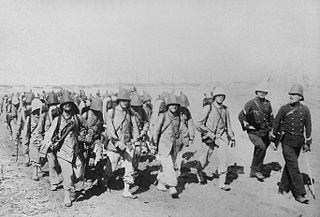
The Second Madagascar expedition was a French military intervention which took place in 1894–95, sealing the conquest of the Merina Kingdom on the island of Madagascar by France. It was the last phase of the Franco-Hova War and followed the First Madagascar expedition of 1883–85.
The Menalamba rebellion was an uprising in Madagascar by the Sakalava people that emerged in central Madagascar in response to the French capture of the royal palace in the capital city of Antananarivo in September 1895. it spread rapidly in 1896, threatening the capital, but French forces were successful in securing the surrender of many rebel groups in 1897. Elements of the rebellion continued sporadically until 1903.

Christianity in Madagascar is practiced by 85.3% of Madagascar's population according to the Pew Research Center in 2010, often in syncretic form with traditional religious practices. Protestantism was introduced by the first envoys of the London Missionary Society in 1818, who proselytized and taught literacy through a Malagasy language Bible at the public schools they established in the highlands at the request of King Radama I. The number of converts remained low but gradually grew under repression during the reign of his successor, Queen Ranavalona I, and the more permissive religious policies of her son, Radama II, and his widow, Queen Rasoherina.

Princess Marie-Louise Razafinkeriefo of Madagascar was the last heir apparent and pretender to the throne of the Kingdom of Madagascar. She was a grandniece, and the adoptive daughter, of Ranavalona III. During World War II, she worked as a nurse and was awarded the Legion of Honour by the French government for her medical service.

Razafinandriamanitra (1882–1897) was a Malagasy princess and a niece of Ranavalona III. She was the heiress presumptive of the Kingdom of Madagascar until the monarchy was abolished in 1897.
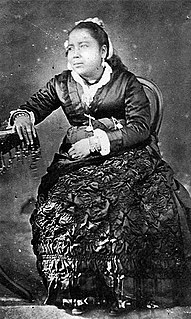
Rasendranoro was a Malagasy princess and older sister of Ranavalona III.


















